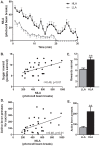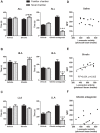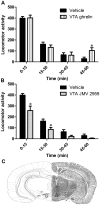Ghrelin influences novelty seeking behavior in rodents and men
- PMID: 23227170
- PMCID: PMC3515575
- DOI: 10.1371/journal.pone.0050409
Ghrelin influences novelty seeking behavior in rodents and men
Abstract
Recent discoveries indicate an important role for ghrelin in drug and alcohol reward and an ability of ghrelin to regulate mesolimbic dopamine activity. The role of dopamine in novelty seeking, and the association between this trait and drug and alcohol abuse, led us to hypothesize that ghrelin may influence novelty seeking behavior. To test this possibility we applied several complementary rodent models of novelty seeking behavior, i.e. inescapable novelty-induced locomotor activity (NILA), novelty-induced place preference and novel object exploration, in rats subjected to acute ghrelin receptor (growth hormone secretagogue receptor; GHSR) stimulation or blockade. Furthermore we assessed the possible association between polymorphisms in the genes encoding ghrelin and GHSR and novelty seeking behavior in humans. The rodent studies indicate an important role for ghrelin in a wide range of novelty seeking behaviors. Ghrelin-injected rats exhibited a higher preference for a novel environment and increased novel object exploration. Conversely, those with GHSR blockade drastically reduced their preference for a novel environment and displayed decreased NILA. Importantly, the mesolimbic ventral tegmental area selective GHSR blockade was sufficient to reduce the NILA response indicating that the mesolimbic GHSRs might play an important role in the observed novelty responses. Moreover, in untreated animals, a striking positive correlation between NILA and sucrose reward behavior was detected. Two GHSR single nucleotide polymorphisms (SNPs), rs2948694 and rs495225, were significantly associated with the personality trait novelty seeking, as assessed using the Temperament and Character Inventory (TCI), in human subjects. This study provides the first evidence for a role of ghrelin in novelty seeking behavior in animals and humans, and also points to an association between food reward and novelty seeking in rodents.
Conflict of interest statement
Figures






References
-
- Cloninger CR (1986) A unified biosocial theory of personality and its role in the development of anxiety states. Psychiatr Dev 4: 167–226. - PubMed
-
- Zuckerman M (1990) The psychophysiology of sensation seeking. J Pers 58: 313–345. - PubMed
-
- Dellu F, Piazza PV, Mayo W, Le Moal M, Simon H (1996) Novelty-seeking in rats–biobehavioral characteristics and possible relationship with the sensation-seeking trait in man. Neuropsychobiology 34: 136–145. - PubMed
-
- Piazza PV, Deminiere JM, Maccari S, Mormede P, Le Moal M, et al. (1990) Individual reactivity to novelty predicts probability of amphetamine self-administration. Behav Pharmacol 1: 339–345. - PubMed
-
- Pierce RC, Crawford CA, Nonneman AJ, Mattingly BA, Bardo MT (1990) Effect of forebrain dopamine depletion on novelty-induced place preference behavior in rats. Pharmacol Biochem Behav 36: 321–325. - PubMed
Publication types
MeSH terms
Substances
LinkOut - more resources
Full Text Sources

